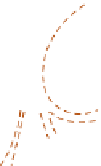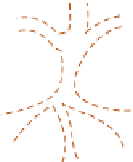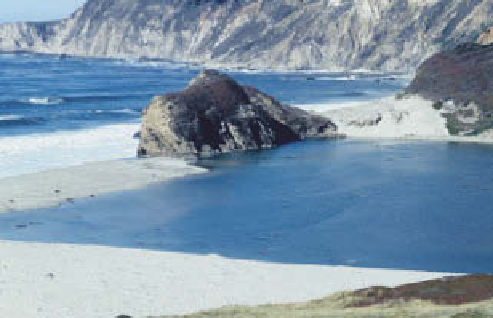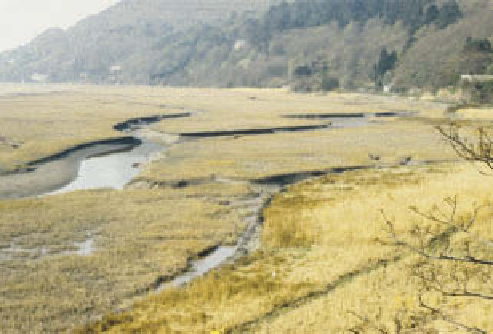Geoscience Reference
In-Depth Information
6($
FLOOD TIDE
EBB TIDE
/$*221
Storm washover
lobe
Ephemeral
delta/lobe
Barrier
Submerged
channel
Tidal jet
Tidal current
Plate 17.5
Salt-marsh zonation, Mawddach estuary, mid-
Wales. The lower marsh commences behind sandbanks
the marsh during the tidal cycle. The upper reed marsh (right)
is inundated less often and grades inland into freshwater
marsh.
Photo: Ken Addison
here develop their own ephemeral deltas and lobes but the
same pass may be used on both ebb and flood tides.
Source: Partly after Carter (1988)
Tidal flats
, protected from large waves and fringed by
salt marsh
and
mangrove swamp
in temperate and
tropical latitudes respectively, dominate the estuarine and
lagoonal intertidal landsystem. Beaches and dunes are
rare. Clear patterns of particle size, bedforms and related
vegetation succession emerge, despite complex two-way
movements of water and sediment bodies which migrate
with river and tidal pulses. Sand moves as bed load and
is deposited most commonly in non-turbid outer and
lower parts of the system where currents are at their
strongest. Tidal sandflats exhibiting large-scale
megaripple
and
sand wave
bedforms attest to their scour. Mud is
moved and deposited from turbid suspension in low-
energy inner and upper estuarine environments. A
halophyte
(salt-tolerant) vegetation succession responds
to, and in turn assists, this zonation. Pioneer algal mats
help to arrest and stabilize mud particles. This permits
grasses, sedges and rushes to colonize the upper intertidal
zone, with its progressively shorter and fewer periods of
tidal inundation (
Plate 17.5
).
Puccinellia maritima
(salt-
marsh grass),
Spartina
spp. (cord grass) and
Juncetum
spp.
(salt-marsh rush) are the principal members of temperate
salt-marsh communities. The halosere may merge inland
with a freshwater hydrosere and become attractive
to reclamation by human intervention. The Ijsselmeer in
Holland is the most celebrated European example.
Lagoons are floored by muds, except where tidal action is
strong near passes or they receive terrigenous sediment
and sand, blown or washed over the barrier during storms.
Carbonate muds form where biological activity is intense
and lagoons may house
stromatolites
(algal mats) and
bioherms
or prominent shell beds.
Barriers and barrier islands
Barriers, as their general name suggests, bar advancing
waves and buffer or protect the coastline from wave
energy. They line approximately 15 per cent of the global
coastline and assume one or more of four principal forms.
Breaking waves and surf create sand or shingle
beaches
in nearshore and foreshore zones described earlier. Parallel







































































































